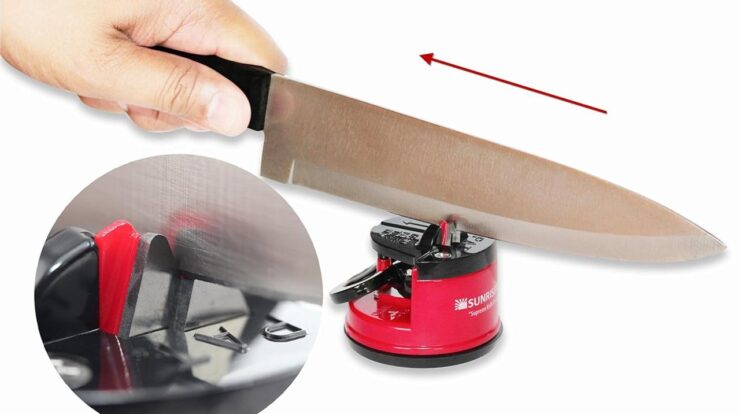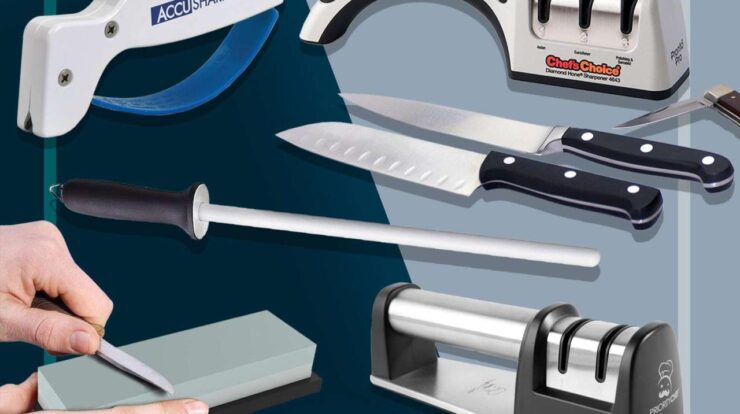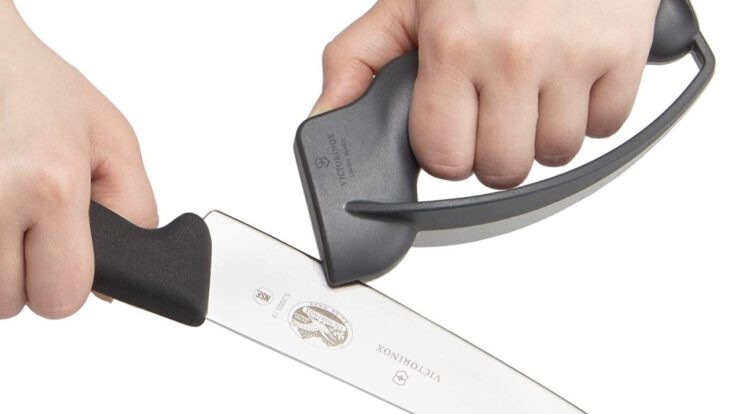Knife sharpener – Step into the world of knife sharpening, where a sharp blade is not just a kitchen essential but an emblem of culinary prowess. Whether you’re a seasoned chef or a home cook who appreciates the art of precision cutting, this guide will equip you with all the knowledge and techniques you need to keep your knives razor-sharp and ready for any culinary challenge.
From understanding the different types of sharpeners to mastering advanced sharpening techniques, this comprehensive guide will guide you through the fascinating world of knife sharpening. Get ready to unlock the secrets of achieving exceptional sharpness and elevate your cooking game to new heights.
Types of Knife Sharpeners
Knife sharpeners come in a wide range of types, each with its own advantages and disadvantages. Understanding the different types available can help you choose the best sharpener for your needs.
Manual Sharpeners
Manual sharpeners require you to physically move the knife blade across a sharpening surface. They are typically more affordable and compact than electric sharpeners.
- Sharpening Stones:Natural or ceramic stones that provide a precise and controlled sharpening experience. However, they require skill and practice to use effectively.
- Sharpening Steels:Long, rod-shaped sharpeners that are used to hone and align the blade edge. They are easy to use but may not be suitable for heavily damaged blades.
- Pull-Through Sharpeners:Compact devices with pre-set sharpening angles that allow you to sharpen knives by pulling them through the slots. They are convenient but may not offer the same level of precision as other manual sharpeners.
Electric Sharpeners
Electric sharpeners use a motorized mechanism to sharpen knives. They are generally faster and easier to use than manual sharpeners.
- Belt Sharpeners:Use a rotating abrasive belt to sharpen knives. They provide consistent and precise results but can be more expensive.
- Disc Sharpeners:Feature rotating discs that sharpen knives by grinding them against a coarse surface. They are faster than belt sharpeners but may not be as versatile.
- Pull-Through Electric Sharpeners:Similar to manual pull-through sharpeners but powered by an electric motor. They offer convenience and speed but may not provide the same level of control as other electric sharpeners.
The best type of knife sharpener for you depends on factors such as the type of knives you own, your sharpening skills, and your budget. Manual sharpeners offer more control and precision, while electric sharpeners are faster and easier to use.
By understanding the different types available, you can make an informed decision and choose the sharpener that best meets your needs.
Factors to Consider When Choosing a Knife Sharpener
Selecting the right knife sharpener is crucial to maintain the sharpness and longevity of your knives. Several factors should be taken into account when making your choice.
Blade Material
The material of your knife’s blade plays a significant role in determining the type of sharpener you need. Ceramic knives require specialized sharpeners, while steel blades can be sharpened using a wider range of options.
Angle
The angle at which the blade is sharpened is critical. Different knives have different optimal sharpening angles, and using the incorrect angle can damage the blade. It’s important to choose a sharpener that allows you to set the correct angle for your knives.
Grit
The grit of a sharpener refers to the coarseness or fineness of the abrasive material. Lower grit sharpeners remove more material, creating a sharper edge, while higher grit sharpeners refine the edge and remove burrs.
Specific Needs
Consider your specific sharpening needs when choosing a sharpener. If you only need to touch up the edges of your knives occasionally, a manual sharpener may suffice. However, if you need to sharpen heavily dulled knives or sharpen a variety of blade types, an electric sharpener may be a better option.
How to Use a Knife Sharpener
Sharpening knives is a crucial skill for any home cook or professional chef. A sharp knife not only cuts more efficiently, but also reduces the risk of accidents. There are several types of knife sharpeners available, each with its own advantages and disadvantages.
In this section, we’ll provide a step-by-step guide on how to use different types of knife sharpeners, including safety precautions and tips for optimal results.
Manual Knife Sharpeners
- Whetstones:Whetstones are rectangular stones made of natural or synthetic materials. They come in various grits, with lower grits used for coarse sharpening and higher grits for fine sharpening. To use a whetstone, soak it in water for a few minutes.
Hold the knife at a 15-20 degree angle to the stone and move it back and forth in a circular motion. Apply light pressure and gradually increase the pressure as you sharpen.
- Honing Steels:Honing steels are round or oval rods made of steel or ceramic. They are used to realign the knife’s edge rather than remove metal. To use a honing steel, hold the knife at a 15-20 degree angle to the steel and draw it down the length of the blade in a smooth, sweeping motion.
Repeat on the other side of the blade.
Electric Knife Sharpeners
- Pull-Through Sharpeners:Pull-through sharpeners are simple to use and can quickly sharpen knives. However, they can be less precise than other methods and may remove too much metal if not used carefully. To use a pull-through sharpener, simply insert the knife into the slot and pull it through in a single motion.
- Electric Sharpeners:Electric sharpeners are more expensive than pull-through sharpeners, but they offer more precise sharpening and can be used on a wider variety of knives. To use an electric sharpener, simply insert the knife into the slot and follow the manufacturer’s instructions.
Safety Precautions
- Always wear gloves when sharpening knives.
- Keep the knife sharpener stable while sharpening.
- Never touch the blade with your bare hands.
- Inspect the knife for any nicks or burrs after sharpening.
Tips for Optimal Results
- Use the correct type of sharpener for your knife.
- Maintain a consistent angle while sharpening.
- Apply light pressure and let the sharpener do the work.
- Sharpen knives regularly to maintain their edge.
- Store knives in a dry place to prevent rust.
Maintenance and Care of Knife Sharpeners
Maintaining the sharpness of your knives is essential for efficient and safe food preparation. Knife sharpeners play a crucial role in maintaining the sharpness of your knives. Therefore, it is equally important to ensure the proper maintenance and care of your knife sharpeners to ensure their longevity and effectiveness.
Cleaning
Cleaning your knife sharpener regularly removes any debris or metal shavings that may accumulate during the sharpening process. Wipe down the exterior of the sharpener with a damp cloth and use a soft brush or compressed air to remove any loose particles.
For more thorough cleaning, refer to the manufacturer’s instructions.
Lubrication
Lubrication helps reduce friction and wear on the moving parts of your knife sharpener. Apply a small amount of lubricant, such as mineral oil or a lubricant specifically designed for knife sharpeners, to the moving parts as per the manufacturer’s instructions.
Avoid over-lubricating, as excess lubricant can attract dirt and debris.
Storage
Proper storage protects your knife sharpener from dust, moisture, and accidental damage. Store the sharpener in a dry, clean location, preferably in its original packaging or a protective case. Avoid storing the sharpener near heat sources or in areas with excessive humidity.
Tips for Extending Lifespan
- Avoid using the sharpener on damaged or excessively dull knives.
- Sharpen knives only as often as necessary.
- Follow the manufacturer’s instructions for proper use and maintenance.
- Store the sharpener properly when not in use.
Knife Sharpening Techniques
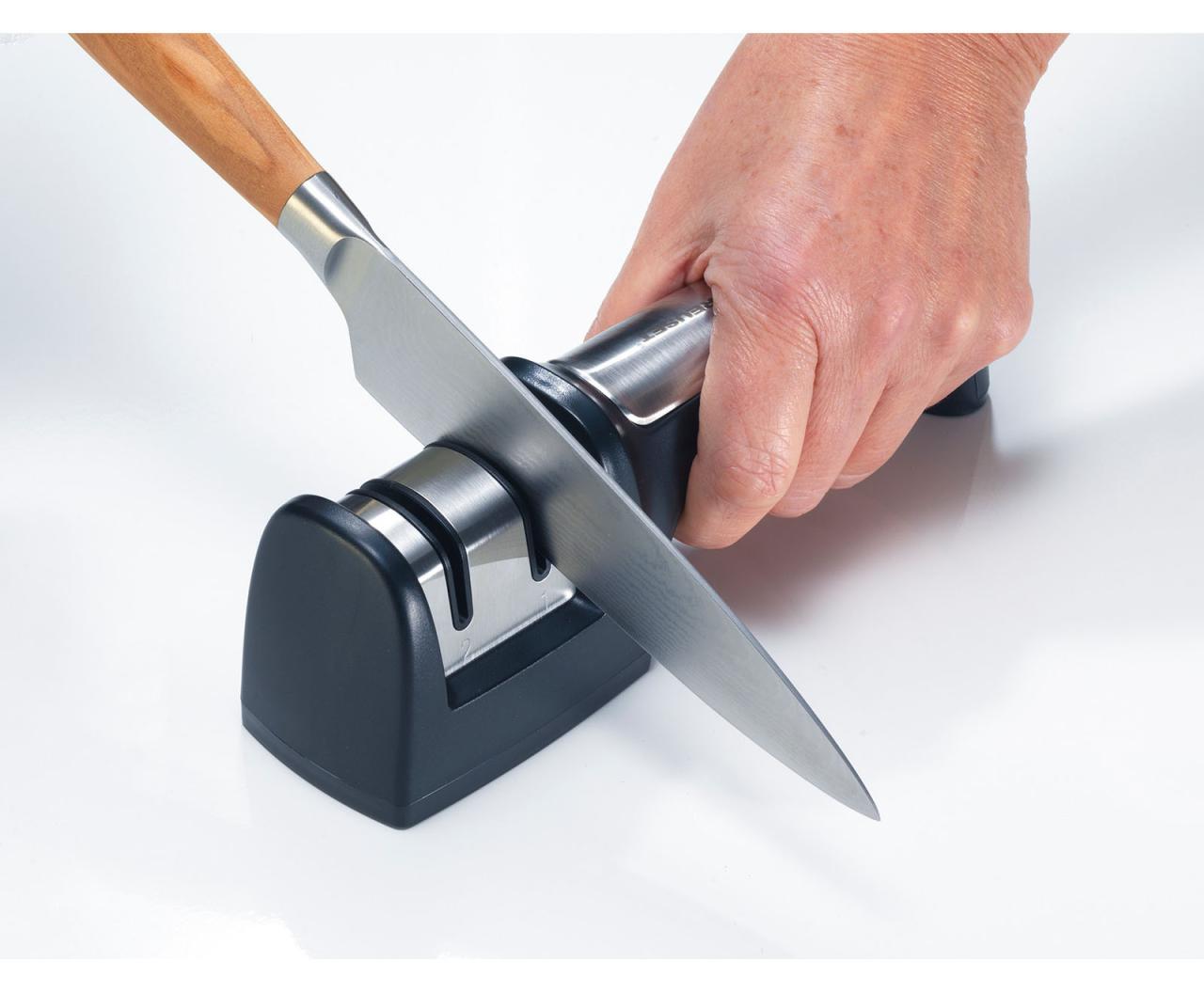
Achieving a sharp knife requires the right technique. Various methods exist, each with its own advantages and drawbacks. Understanding these techniques empowers you to select the most suitable approach for your needs.
Manual Sharpening
- Whetstones:Natural or ceramic stones provide a versatile sharpening surface. They offer precise control and allow for different angles and grits, catering to various knife types and desired sharpness levels.
- Sharpening Steels:Honing steels realign the knife’s edge without removing significant metal. They are ideal for quick touch-ups and maintaining an existing edge but cannot restore a severely dull knife.
- Sharpening Rods:Similar to sharpening steels, sharpening rods are used to realign the edge. However, they are typically round in cross-section, providing a different feel and requiring a different technique.
Electric Sharpeners
- Belt Sharpeners:These machines use abrasive belts to remove metal and create a sharp edge. They are fast and convenient but may require some skill to achieve consistent results.
- Disc Sharpeners:Disc sharpeners use rotating discs to sharpen the knife. They are typically easier to use than belt sharpeners but may not provide the same level of control.
Pros and Cons
Manual Sharpening:
- Pros:Precise control, customizable angles and grits, suitable for all knife types.
- Cons:Requires skill and practice, time-consuming.
Electric Sharpeners:
- Pros:Fast, convenient, easy to use.
- Cons:Less control over sharpening angle and grit, may remove more metal than necessary.
Achieving Different Levels of Sharpness
The desired sharpness level depends on the intended use of the knife. A general-purpose kitchen knife may require a 15-20 degree angle, while a specialized cutting tool may need a finer 10-15 degree angle. Sharpening stones or electric sharpeners with adjustable angles allow you to achieve the desired sharpness.
Benefits of Using a Knife Sharpener
Investing in a knife sharpener offers numerous advantages that enhance the overall kitchen experience. A sharp knife is a safe knife, and it also delivers optimal performance and hygiene.
Improved Cutting Performance
Sharp knives effortlessly slice through ingredients, making food preparation a breeze. They require less force, reducing strain on the hands and wrists. The precise cuts minimize food waste and create aesthetically pleasing dishes.
Enhanced Safety
Dull knives require more force to cut, increasing the risk of accidents. A sharp knife glides through ingredients with ease, reducing the chances of slipping or cutting oneself. By maintaining sharp knives, you create a safer cooking environment.
Improved Hygiene
Dull knives tend to tear food rather than cut it cleanly, creating jagged edges that trap bacteria. Sharp knives produce smooth, clean cuts, minimizing the risk of food contamination. This is especially crucial when handling raw meat or produce.
Safety Precautions for Knife Sharpening
Knife sharpening is an essential task for maintaining sharp and functional knives. However, it’s crucial to prioritize safety throughout the process to avoid potential hazards.
When sharpening knives, always wear cut-resistant gloves to protect your hands from accidental cuts. Additionally, ensure a stable and non-slip work surface to prevent the knife or sharpener from moving unexpectedly.
Potential Hazards
- Cuts and lacerations from sharp knife blades.
- Hand injuries from slipping or mishandling the knife or sharpener.
- Eye injuries from flying metal particles or debris.
Tips for Safe Handling
- Always keep the knife pointed away from your body and others.
- Use a sharpener designed specifically for the type of knife you’re sharpening.
- Follow the manufacturer’s instructions carefully.
- Inspect the knife and sharpener regularly for any damage or wear.
- Store knives and sharpeners safely when not in use.
Troubleshooting Common Knife Sharpening Problems

Sharpening knives can be a rewarding task, but it’s not without its challenges. Here are some common problems you may encounter and how to resolve them:
Uneven Sharpening, Knife sharpener
Cause
Inconsistent pressure or angle while sharpening.
Solution
Use a sharpening guide or maintain a consistent angle throughout the sharpening process.
Burrs
Cause
Excess metal is removed, creating a thin lip on the blade’s edge.
Solution
Remove burrs by lightly honing the blade on a fine-grit stone or ceramic rod.
Damage to the Blade
Cause
Excessive force, using the wrong sharpening tool, or improper technique.
Solution
Use a sharpening tool specifically designed for the type of knife and apply moderate pressure. Follow the manufacturer’s instructions carefully.
Additional Tips
Clean the knife
Remove any dirt or debris from the blade before sharpening.
Inspect the blade
Check for nicks or chips before sharpening.
Lubricate the stone
Use water or a honing oil to reduce friction and prevent overheating.
Sharpen regularly
Regular sharpening will prevent the blade from becoming too dull.
Seek professional help
If you encounter persistent problems or damage the blade, consider consulting a professional sharpener.
Advanced Knife Sharpening Techniques
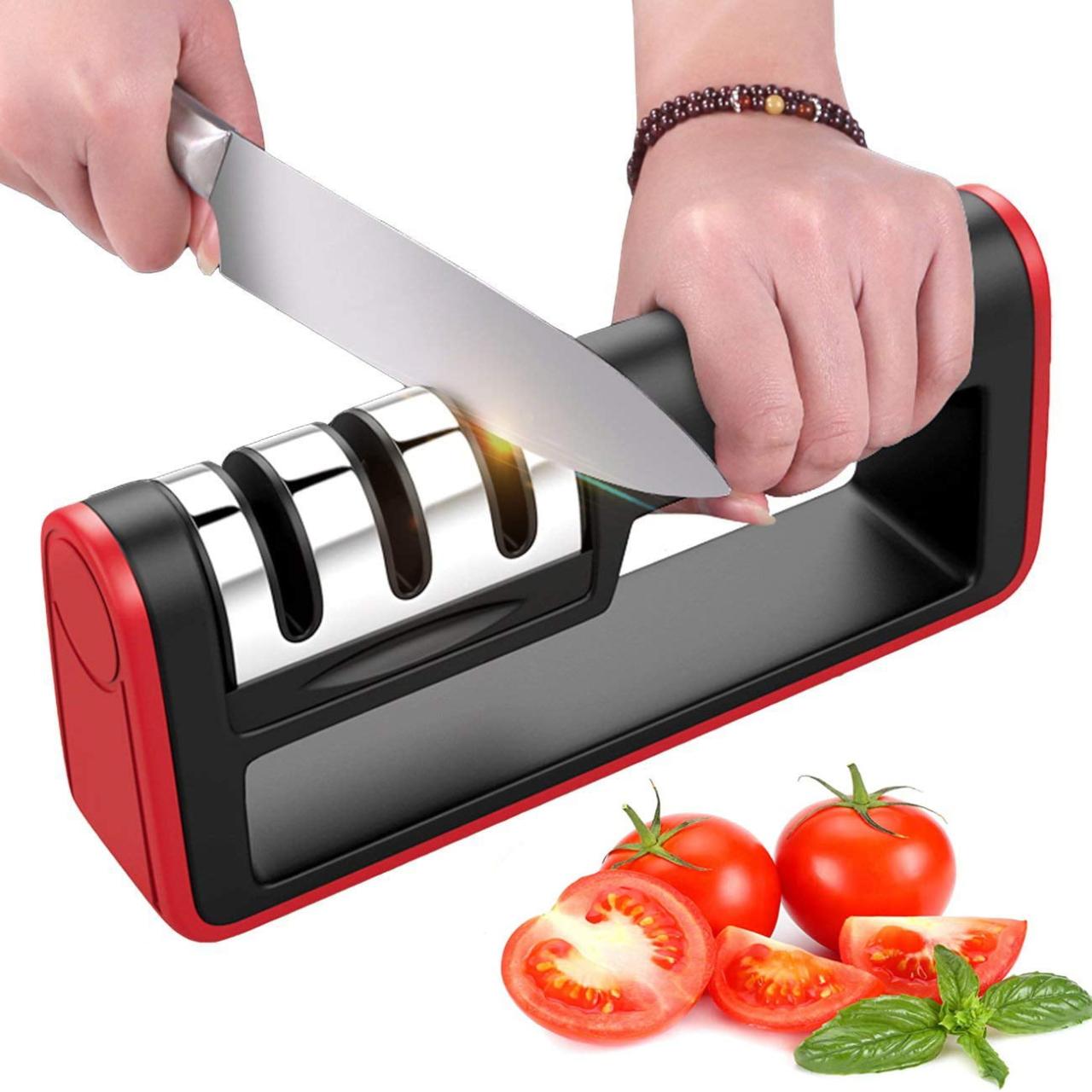
Sharpening knives to exceptional sharpness demands mastery of advanced techniques. This guide explores stropping, honing, and whetstone methods to help you achieve razor-sharp blades.
Stropping
Stropping polishes and aligns the knife’s edge on a leather or fabric strop coated with a fine abrasive. By drawing the blade over the strop, you refine the edge and enhance its sharpness.
Honing
Honing involves using a honing steel to realign the blade’s edge. Unlike sharpening, honing doesn’t remove metal but straightens the microscopic teeth on the edge, restoring its sharpness.
Whetstones
Whetstones, also known as sharpening stones, come in various grits. Coarse-grit stones remove metal to create a new edge, while finer-grit stones refine and polish the edge. Mastering whetstone sharpening requires patience and practice.
Final Conclusion
As you embark on your knife sharpening journey, remember that a sharp knife is not only a valuable tool but also a testament to your culinary skills. Embrace the art of knife sharpening, and let the precision and sharpness of your blades inspire culinary creations that will tantalize your taste buds and impress your dinner guests.
Helpful Answers
What is the best type of knife sharpener for home use?
For home cooks, a manual sharpener like a whetstone or a pull-through sharpener offers a great balance of affordability, ease of use, and effectiveness.
How often should I sharpen my knives?
The frequency of sharpening depends on usage and the type of knife. As a general rule, sharpen your knives every few months or when you notice a decrease in cutting performance.
Can I sharpen all types of knives?
While most knives can be sharpened, some knives like serrated or ceramic knives require specialized sharpeners or professional sharpening services.
